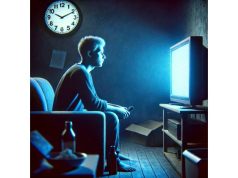
Endless scrolling can feel harmless—until minutes blur into hours, conversations fade into background noise, and every spare second gravitates to a glowing screen. Social media addiction turns a handy tool for connection into an all-consuming habit that hijacks attention, mood, and sleep. What begins as a quick dopamine hit from likes or memes can morph into anxiety when Wi-Fi drops, phantom buzzes, and a compulsion to document life instead of live it. This guide unpacks how common the condition truly is, why it develops, how to recognize the earliest warning signs, and—most importantly—how to reclaim your time, focus, and real-world joy.
Table of Contents
- Digital Ubiquity: How Widespread and Growing Is the Problem?
- Why We Scroll: Neurological Hooks, Personality Traits, and Social Pressures
- Early Red Flags, Habit Trackers, and Formal Screening Tools
- Ripple Effects on Sleep, Mood, Productivity, and Relationships
- Rebooting Digital Life: Evidence-Based Treatments and Sustainable Habits
- FAQ
Digital Ubiquity: How Widespread and Growing Is the Problem?
Nearly everyone is online, but not everyone is free. Recent global surveys estimate that 4.9 billion people—over 60 percent of humanity—log into at least one social platform monthly. Among them, 30 to 40 percent report spending more time scrolling than intended on most days. Researchers suggest that 6 to 10 percent of users exhibit compulsive patterns severe enough to meet behavioral-addiction criteria: loss of control, mounting negative consequences, and persistent use despite intentions to stop.
Demographic hot spots.
- Teens and young adults (ages 13-24): average 3–5 hours daily on social media, with FOMO (fear of missing out) and peer reinforcement driving constant checking.
- Remote workers: blurred boundaries between job tasks and social feeds lead to “silent scrolling” during virtual meetings.
- Parents of young children: quick dopamine fixes during nap times can evolve into late-night binge scrolling that disrupts sleep.
Platform design accelerates use. Features like infinite scroll, autoplay videos, real-time notifications, and algorithmic content curation perfect the “stickiness” of feeds, keeping thumbs in motion long after conscious goals are met.
Pandemic aftershocks. Lockdowns normalized virtual gatherings and doomscrolling. Even as restrictions ease, many people find they cannot easily roll back screen hours; neural reward pathways and daily routines are already rewired.
The takeaway: Social media’s ubiquity makes overuse easy to rationalize. Yet statistical trends confirm a sizeable population whose online engagement crosses the line into genuine addiction requiring targeted intervention.
Why We Scroll: Neurological Hooks, Personality Traits, and Social Pressures
Social media addiction emerges from a layered interplay of brain chemistry, individual temperament, and environmental cues.
Neural reward circuitry
- Dopamine bursts. Each like, comment, or new follower triggers micro-doses of dopamine in the nucleus accumbens, reinforcing the behavior much like slot-machine wins.
- Variable-ratio reinforcement. Notifications arrive at irregular intervals, mirroring casino reward schedules that are proven to be highly addictive.
- Social validation loop. Sharing a post releases oxytocin and serotonin when feedback is positive, creating emotional warmth that the brain quickly learns to chase.
Psychological and personality drivers
- High neuroticism. Individuals prone to anxiety or self-consciousness often seek reassurance through social feedback.
- Low conscientiousness. Those who struggle with self-regulation or planning are more vulnerable to thoughtless scrolling.
- Perfectionism and comparison. People with unattainable self-standards use curated feeds to gauge worth, trapping themselves in loops of envy and self-critique.
- Sensation seeking. Rapid content variety caters to users who crave novelty and stimulation.
Environmental accelerants
- Push notifications by default. Red badges and vibration alerts hijack attention even during face-to-face conversations.
- 24/7 connectivity. High-speed mobile data eliminates natural pauses (e.g., waiting for a desktop computer) that once limited engagement.
- Social norms. Networking for work, staying in family group chats, or keeping up with school announcements blurs necessity and overuse.
- Influencer economy. Everyday users aspire to monetizable “creator” status, justifying excessive posting and analytics checking as potential income strategies.
Key insight: Social media addiction is not a willpower flaw; it is a predictable outcome when wired human neurobiology meets billion-dollar optimization engines and constant societal pressure to be online.
Early Red Flags, Habit Trackers, and Formal Screening Tools
Because phone use is socially acceptable, early warning signs often hide in plain sight. Recognizing them early turns down the algorithmic volume before it drowns out daily life.
Behavioral red flags
- Reaching for the phone within 30 seconds of waking or whenever idle.
- Phantom vibrations: feeling the phone buzz when it hasn’t.
- Scrolling while eating, watching TV, or even walking across streets.
- Feeling anxious or irritable when Wi-Fi is slow or the battery is low.
- Ignoring in-person company, deadlines, or lectures to “just check one thing.”
Self-audit questions
- Have screen-time reports surprised or embarrassed you recently?
- Do you lose track of time on apps and end up staying up later than planned?
- Have friends or family commented on your distractedness or constant posts?
- Does deleting an app lead to re-installation within a few days?
Answering “yes” to several items signals a need for deeper evaluation.
Validated assessment tools
- Bergen Social Media Addiction Scale (BSMAS): a six-item questionnaire measuring salience, tolerance, mood modification, relapse, withdrawal, and conflict.
- Social Media Disorder Scale (SMDS): nine criteria paralleling gaming-disorder guidelines.
- Smartphone Addiction Scale (SAS-SF): gauges broader mobile overuse that often overlaps with social platforms.
Digital habit trackers
- Built-in tools: iOS Screen Time, Android Digital Wellbeing dashboards categorize app minutes, pickups, and notification counts.
- Third-party apps: Forest, Freedom, and RescueTime block or limit selected platforms, offering real-time feedback loops.
Tip: Pair metrics with journaling to identify emotional triggers—stress, boredom, loneliness—so interventions fit real-life patterns, not generic quotas.
Ripple Effects on Sleep, Mood, Productivity, and Relationships
Compulsive scrolling steals more than time; the hidden costs surface across multiple life domains.
Physical and cognitive health impacts
- Blue-light insomnia. Nighttime exposure suppresses melatonin, delays sleep onset, and reduces REM cycles, leading to next-day fatigue.
- Eye strain. Dryness, blurred vision, and headaches arise from constant near-focus and limited blinking.
- “Text neck” and carpal tunnel. Forward-head posture and repetitive thumb motions inflame muscles and nerves.
- Fragmented attention. Rapid content shifts erode sustained focus, increasing mind-wandering during study or work.
Mental-health consequences
- Social comparison anxiety. Highlight reels of peers’ successes trigger feelings of inadequacy.
- Depressive symptoms. Passive consumption (scrolling without interacting) correlates with lower mood and self-esteem.
- Loneliness paradox. Online connection substitutes for face-to-face time, leaving emotional needs unmet.
- Cyberbullying trauma. Negative comments or harassment exacerbate stress and self-doubt.
Relationship strains
- Phubbing. “Phone snubbing” partners or friends erodes trust and intimacy.
- Conflict over privacy. Constant posting of children or family events sparks disagreements about boundaries.
- Jealousy loops. Monitoring ex-partners or comparing relationships online fuels insecurity.
Academic and professional fallout
- Reduced deep-work capacity lowers creativity and problem-solving.
- Procrastination fueled by quick dopamine hits leads to missed deadlines and last-minute cramming.
- Public posts during work hours can jeopardize professional reputation.
Core message: Social media addiction gradually reshapes brain physiology, daily routines, and interpersonal bonds—making intervention not merely optional self-improvement but critical health care.
Rebooting Digital Life: Evidence-Based Treatments and Sustainable Habits
The goal is not to live off-grid but to shift from compulsive to intentional use—turning technology into a servant, not a master. Effective recovery blends psychological treatment, tech tools, lifestyle redesign, and social accountability.
Cognitive and behavioral therapies
- Cognitive-Behavioral Therapy for Internet Addiction (CBT-IA): restructures distorted thoughts such as “I’ll miss out if I don’t check now,” while installing schedule-based usage and offline coping skills.
- Dialectical Behavior Therapy (DBT) skills: distress-tolerance and emotion-regulation modules help users ride out FOMO spikes without grabbing the phone.
- Acceptance and Commitment Therapy (ACT): teaches mindfulness of urges and alignment with life values that matter more than endless notifications.
Digital hygiene strategies
- Notification triage: disable non-human pings (likes, follows); keep only direct messages or essential work alerts.
- Time-boxing: set two or three “social check-in” windows daily, using app timers (Instagram’s “Your Activity,” TikTok’s “Screen Time Breaks”) to log out automatically.
- Monochrome mode: switching phone display to grayscale reduces visual excitement and craving.
- Phone-free zones: designate the dinner table, bedroom, and workstation as device-restricted areas.
- One-screen rule: avoid simultaneous TV-plus-phone multitasking to rebuild single-task focus.
Pharmacological and neurofeedback adjuncts
- SSRIs or SNRIs: can alleviate co-existing anxiety or depression that fuels excessive scrolling.
- Bupropion: a dopamine-norepinephrine reuptake inhibitor shown to reduce reward cravings in other behavioral addictions.
- Neurofeedback: real-time EEG-based training improves self-regulation of attention networks.
Community and peer support
- Digital-minimalism groups: local or online meetings where members share progress and challenges.
- “Phone-stack” gatherings: friends place phones in a basket during meals; first to retrieve pays for coffee—gamifying accountability.
- Family media plans: collaborative schedules and content rules reduce conflict and model healthy habits for kids.
Offline lifestyle anchors
- Exercise swap: replace morning doomscroll with 20-minute walks; physical activity counteracts dopamine dysregulation and improves mood.
- Hobby revival: crafts, music, gardening, or sports provide tactile satisfaction absent in digital life.
- Mindfulness practice: five-minute breathwork sessions strengthen the meta-awareness needed to notice urge spikes.
- Nature exposure: “green time” replenishes attention span and lowers cortisol more effectively than screen breaks indoors.
Relapse-prevention blueprint
- Trigger journal: record time, mood, location, and purpose when urges arise; review weekly for patterns.
- 90/90 rule: commit to 90 days with social use capped at 90 minutes daily—long enough for neural pathways to recalibrate.
- Ghost-mode vacations: schedule monthly 24-hour digital sabbaths; prepare by informing contacts and downloading maps or tickets offline.
- SOS plan: if an unplanned binge occurs, immediately debrief—what happened, feelings before/after, what safeguard failed—and adjust routines.
- Celebrate milestones: reward 1-, 3-, and 6-month streaks with experiences (day trips, cooking classes) that reinforce offline joy.
Case example: Alex’s revival
Alex, a 22-year-old college senior, racked up eight hours daily on multiple apps, missed assignment deadlines, and felt isolated despite thousands of followers. Through campus counseling, he tried a 30-day cleanse paired with CBT-IA sessions, forest walks, and turning his phone greyscale after 9 p.m. By week six, screen time dropped to under two hours, grades improved, and he joined a rock-climbing club to replace late-night scrolling. Twelve months later, Alex checks social media twice daily for a total of 45 minutes, using it mostly to schedule real-life meet-ups. His journey shows that rewiring habits is tough but entirely doable with structured support.
Essential message: Lasting recovery relies on blending psychological insight with actionable tech tweaks and offline fulfillment—creating a life rich enough that infinite scroll loses its grip.
FAQ
How do I know if I’m addicted or just a heavy user?
If you repeatedly lose control, feel distress without access, and suffer sleep, work, or relationship problems yet keep scrolling, addiction—not mere heavy use—is likely.
Does deleting all apps permanently solve the issue?
For some, a cold-turkey detox helps reset habits, but underlying emotional triggers need addressing; otherwise, the compulsion may surface through other screens or behaviors.
Can children get social media addiction?
Yes. Developing brains are especially vulnerable to dopamine loops. Early boundaries—age-appropriate platforms, screen-time limits—reduce risk of lifelong compulsive patterns.
Will using social media for work keep me addicted?
It can. Separate accounts, desktop-only access, and strict task batching help distinguish professional tasks from recreational rabbit holes.
Do blue-light glasses prevent addiction?
They protect sleep quality but don’t curb compulsive checking. Behavioral changes and notification management remain essential.
Is it okay to keep one favorite platform?
Yes, if usage stays intentional. Choose the platform that delivers genuine value and delete those that mostly trigger mindless scrolls.
How long do dopamine levels take to normalize?
Studies suggest noticeable improvements after three to four weeks of reduced use, though full receptor recalibration may take several months.
Are meditation apps part of the problem?
Used mindfully—with airplane mode on—they serve recovery. Just avoid switching to social feeds immediately after a session.
Can medications alone cure social media addiction?
No. Meds assist with underlying anxiety or depression but must pair with behavioral therapy and digital hygiene for sustainable change.
Where can I find help if there’s no specialist nearby?
Teletherapy platforms, digital-minimalism communities, and CBT-IA workbooks provide structured guidance wherever you have internet access.
Disclaimer: This article is for educational purposes only and should not replace personalized medical, psychological, or technological advice. If you suspect social media addiction, consult qualified professionals for individualized support.
If this guide helped you rethink your scroll habits, please share it on Facebook, X (formerly Twitter), or any network you love. Your support fuels our mission to create clear, compassionate resources. Follow us for more insights—you might inspire someone else’s digital reset today!










